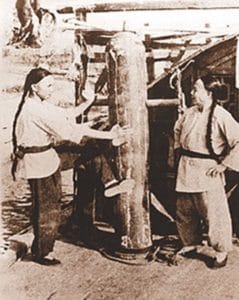The origins of Wing Chun

Wing Chun (Eternal Springtime) is a traditional style of Kung Fu, created over 300 years ago. It has roots in southern China around the Foshan region of Guangzhou. There are many fables about how the style was founded, most of which cannot be verified. Recent research points to a monk called Miu Shin who fused his internal Snake Boxing style (Ermei 12 zhuang) with a softer White Crane Kung Fu system that he learnt from Ng Mui.
The Taiping Rebellion and the Red Junk Opera
Although the origins of the style are ambiguous, its history can be traced from the Red Boat Opera Company of the Mid 19th century. This was during the Taiping Rebellion in the Guangzhou region.
This was a period of civil war in the country, where the southern Chinese people wanted to overthrow the Qing dynasty. The Qing was a Manchurian ruled dynasty that was considered by many to be invading force that had overthrown the previous Ming Chinese dynasty. At least 20 million people died during one of the worst military conflicts in history. Secret societies acting against the Qing such as the Heaven & Earth society were created. This society claimed some of its members were the five survivors from the Shaolin Temple, previously destroyed by the Qing. It is interesting to note that one of the weapons used by the Heaven & Earth society during this period bears a strong resemblance to the Luk dim poon kwan, the 6 ½ point pole that we now see in Wing Chun.
There was also a connection between two brothers from Guangzhou who set up the Small Knives society in the Ding Chun hall in Shanghai. This may well be where the Wing Chun butterfly knives were introduced.
During this period, the Boat Opera was travelling around the country, entertaining locals with a combination of dance, song, acrobatics and martials arts. Due to the costumes, masks, face paints and nomadic lifestyle, the opera group was a perfect cover for revolutionaries. Amongst the members were the following 6 Wing Chun practitioners: Wong Wa-bo, Dai Fa Min Kam, Yik Kam, Law Man Kung, Leung Yee Tai and Hung Gan Biu. From these practitioners lineages of Wing Chun were born, one of which was the Yip Man lineage.
Leung Jan (King of Wing Chun)
Leung Yee Tai and Wong Wah-bo then passed on this extended system to a well-known doctor in Foshan, called Leung Jan. Dr Lueng Jan’s reputation began to travel throughout the country and many contenders came to test is kung fu skills. He’s reputed to have defeated every one of them and was given the title “King of Wing Chun”.
Lueng Jan trained his sons, Leung Tsun and Lueng Bik. He also taught some other students such as Chan Wah Shun. Once Leung retired, he moved to Gulao village. where he taught a different style of Wing Chun which he called Pin Sun, or Side boxing Wing Chun.
Yip Man
Leung Jan’s student Chan Wah Shan continued to teach in Foshan, taking on a total of sixteen students. His last student was Yip Man, a teenager who came from a wealthy family. They could afford the large bai si initial training fee that Chan Wah Shan demanded. Chan Wah Shan taught him for three years, until one day he had a stroke. He asked his second student, Ng Chung-sok, to continue Yip Man’s training after his death.
At the age of sixteen Yip Man moved to Hong Kong to study, where it is claimed that he met and learnt Kung Fu from his SiBak, Lueng Bik. At the age of twenty four he returned to Foshan and became a police officer. He also began teaching kung fu to some of his colleagues, friends and family, but never ran a school there.
In 1949 Yip Man returned to Hong Kong. He was caught up in some financial strife so he decided that he would begin teaching the style more openly. Until this time Wing Chun had always been a secret system, passed onto family members or close friends. Yip Man had many students, most famously a young Bruce Lee. (Although Bruce learnt most of his Wing Chun from his Sihing Wong Shun Leung). He taught many other well-known students such as Leung Sheung, Lok Yiu, Yiu Wan, Wong Shun Leung, Chu Shong-tin, William Chueng, Moy Yat, Lo Man Kam, Hawkins Cheung and many others.
Many of these students went out and tested their skills in Beimo fights against different styles in Hong Kong. Wing Chun got a reputation as a very effective art. Wong Shun Leung was well known for winning many Beimo fights. He used much of this fighting experience to fine tune his kung fu.
